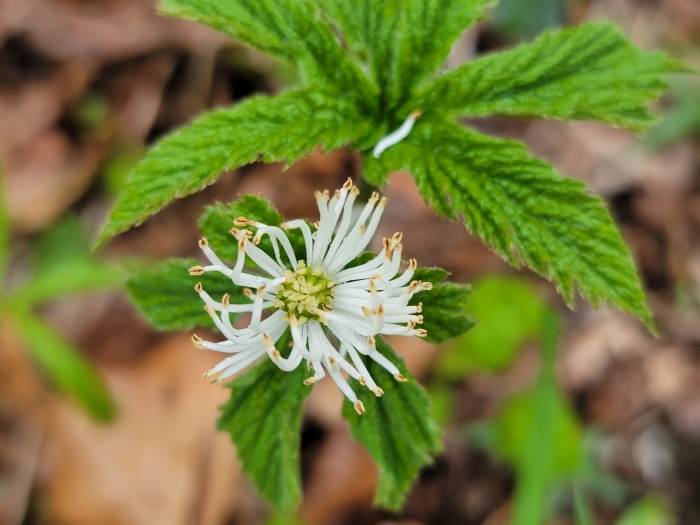Goldenseal
(Hydrastis canadensis)
Goldenseal (Hydrastis canadensis)
/
/

Elias
CC BY 4.0
Image By:
Elias
Recorded By:
Copyright:
CC BY 4.0
Copyright Notice:
Photo by: Elias | License Type: CC BY 4.0 | License URL: http://creativecommons.org/licenses/by/4.0/ | Rights Holder: Elias | Publisher: iNaturalist | Date Created: 2021-04-24T12:52:37-07:00 |
















































Estimated Native Range
Summary
Hydrastis canadensis, commonly known as Goldenseal, is a deciduous perennial herb native to the rich, moist, deciduous forests of the Eastern United States and Ontario, often found in the understory. It typically grows 5 to 15 inches (15–50 cm) tall with a single, hairy, upright, unbranched stem. Mature plants have two palmately lobed leaves and produce a single terminal flower in the spring. The flower lacks true petals but has three small sepals that fall away quickly and numerous white stamens and pistils, making it less conspicuous. After pollination, it develops red, raspberry-like fruits containing one or two seeds. Goldenseal takes 4 to 5 years to reach sexual maturity and flower.
Goldenseal is valued for its medicinal properties, particularly its root, which has been used traditionally by Native Americans and is harvested for various health supplements. It is also appreciated for its foliage and fruit, adding a subtle charm to woodland gardens. In cultivation, it requires part shade and consistent moisture, similar to its native woodland habitat. It thrives in well-drained, loamy soils rich in organic matter. While not commonly used in ornamental horticulture, it can be a unique addition to shade gardens or naturalized areas. Goldenseal is subject to overharvesting in the wild due to its medicinal demand, and gardeners are encouraged to source plants responsibly.CC BY-SA 4.0
Goldenseal is valued for its medicinal properties, particularly its root, which has been used traditionally by Native Americans and is harvested for various health supplements. It is also appreciated for its foliage and fruit, adding a subtle charm to woodland gardens. In cultivation, it requires part shade and consistent moisture, similar to its native woodland habitat. It thrives in well-drained, loamy soils rich in organic matter. While not commonly used in ornamental horticulture, it can be a unique addition to shade gardens or naturalized areas. Goldenseal is subject to overharvesting in the wild due to its medicinal demand, and gardeners are encouraged to source plants responsibly.CC BY-SA 4.0
Plant Description
- Plant Type: Herb
- Height: 0.8-1 feet
- Width: 0.8-1 feet
- Growth Rate: Moderate
- Flower Color: Green, White
- Flowering Season: Spring
- Leaf Retention: Deciduous
Growth Requirements
- Sun: Part Shade
- Water: Medium
- Drainage: Slow, Medium, Fast
Common Uses
Bee Garden, Bird Garden, Edible*Disclaimer: Easyscape's listed plant edibility is for informational use. Always verify the safety and proper identification of any plant before consumption., Low Maintenance
Natural Habitat
Rich, moist, deciduous forests and often in the understory of these environments
Other Names
Common Names: Orangeroot, Yellow-Puccoon, Kanadische Orangewurz, Hidrastis, Raíz De Oro, Fard Inolien, Sceau D’Or, Racirie Jaunisse, Hydrastis Du Canada, Blodstilla
Scientific Names: , Hydrastis canadensis, Hydrastis trifolia, Warnera canadensis, Warnera diphylla, Warnera tinctoria, Warneria canadensis,
GBIF Accepted Name: Hydrastis canadensis L.